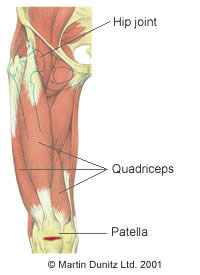| Common Signs & Symptoms | |||||
| Pain | Swelling | Stiffness | Weakness | Instability | Locking |
Patella Fracture Explained
A Patella fracture or broken knee cap, is usually caused by a forceful direct blow to the knee, such as the knee contacting the dashboard of a car in an accident or direct trauma from an opponent during sport. The Patella fracture may consist of a single crack across the kneecap or the kneecap may be broken into several pieces, in what is known as a ‘stellate’ fracture. In some instances a forceful contraction of the Quadriceps muscles can be enough to cause a fracture of the patella. This causes a horizontal crack across the knee cap, which makes it impossible for the patient to straighten their knee.

Patella Fracture Signs & Symptoms
There is immediate intense knee pain. Almost immediately the knee will become swollen and the patient is unlikely to be able to bend the affected knee. If the Patella fracture is right across the knee cap it may be possible to feel a gap.
Patella Fracture Treatment
What you can do
| Consult a sports injury expert | |
| Apply ice packs/cold therapy | |
| Wear a knee brace for warmth & pain relief | |
| Use a buoyancy aid for pool exercises |
If this injury is suspected, the patient should be transferred to the emergency department as soon as possible. The injury will be confirmed with an x-ray. The main differential diagnosis is bi-partite Patella, which is a congenital malformation of the knee cap, where one of the growth centres of the knee cap doesn’t fully fuse with the rest of the bone and the two pieces are joined by cartilage. This may appear like a fracture on an x-ray.
If a fracture is confirmed, subsequent treatment will depend upon the appearance of the fracture fragments. The orthopaedic consultant will aim to restore the knee cap to its original state. This is to prevent later complications due to osteoarthritis of the Patello-Femoral joint (the joint between the knee cap and the thigh bone).
If the fracture is in the form of a small crack, and the knee cap retains its original position, the consultant usually decides to immobilise the knee joint in a plaster cast for 6 weeks to allow the two segments to unite. If the fracture is caused by more force and the fragments of the knee cap are severely disrupted, it is usually necessary to operate and restore the knee cap to its original position using tensioned wire. Where the damage to the kneecap is so great that normal alignment is impossible, it may be necessary to remove the knee cap completely. This is to prevent the development of osteoarthritis in the Patello-femoral joint. Where the kneecap is removed the leg is usually put in a plaster cast for 6 weeks.
The rehabilitation protocols vary according to the choice of technique used by the orthopaedic consultant . Some consultants allow the patient to come out of the plaster after 2 to 3 weeks and use a knee brace instead. This allows the physiotherapist to begin work on restoring range of movement and strength.
The initial goals of physiotherapy treatment are to reduce knee pain and knee swelling. Ice Packs can be applied for periods of twenty minutes every couple of hours (never apply ice directly to the skin as it can cause an ice burn). The ice packs relieve pain and reduce bleeding within the tissue. The Aircast Knee Cryo/Cuff is the most effective method of providing ice therapy and can be used for the home treatment of knee injuries and knee pain. It can provide continuous ice cold water and compression for 6 hours, and significantly reduce knee pain and knee swelling.
At around six weeks, as long as there is no pain, the patient can usually begin using the static cycle. At between 6 and 12 weeks, once the range of movement and strength have been restored, the level of activity can be progressed under the supervision of a chartered physiotherapist . Pool running and exercises in water using a Bouyancy Belt can help to restore full movement
Long term maintenance of Quadriceps strength is thought to be particularly important to prevent the onset of Patello-femoral osteoarthritis. Knee pain following a Patella fracture is quite common, even after the fracture has healed. Many people find that a Knee Brace or Support helps to provide warmth and alleviates their knee pain symptoms.
Patella Fracture Prevention
Some form of protective padding over the knees may be helpful, particularly in those people who are engaged in activities that might lead them to fall on their knees, such as skateboarders and handball players.


